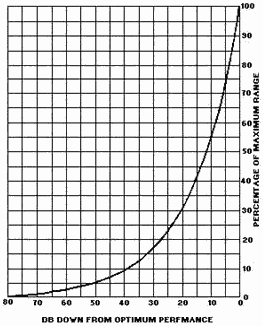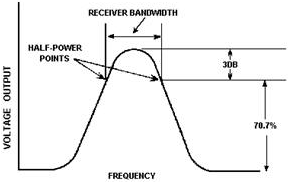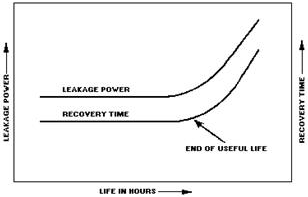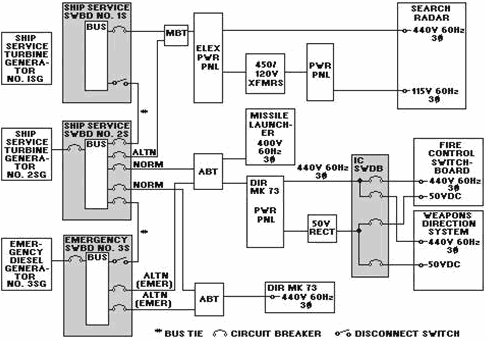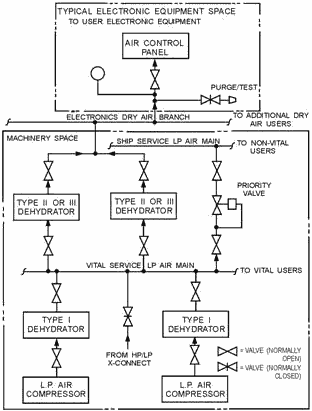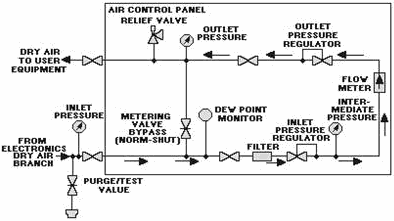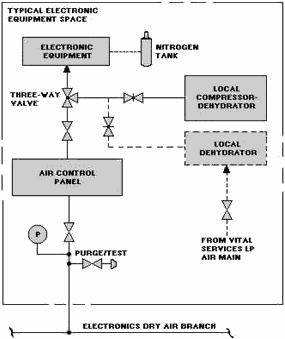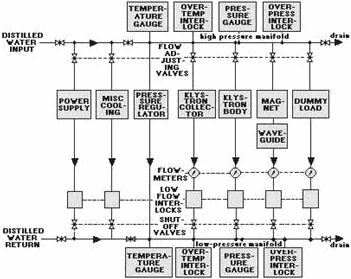Module 18 - Radar Principles |
||||||||||||||||||||||||||||||||||||||||||||||||||
|
Module 18 − Radar Principles
Pages i, 1−1, 1−11, 1−21, 1−31, 1−41, 2−1, 2−11, 2−21, 2−31, 2−41, 3−1, 3−11, 3−21, 4−1, 4−11, 4−21, AI−1, AII−1, Index−1 to 3
Figure 4-8. - System performance versus maximum range.
The sensitivity of the radar receiver is a measure of its ability to pick up weak signals. The greater the sensitivity of the receiver, the better the receiver picks up weak signals. You can determine receiver sensitivity by measuring the power level of the MINIMUM DIsCERNIBLE Signal (MDS). MDS is defined as the weakest signal that produces a visible receiver output (on a scope). Its value is determined by the receiver output noise level (noise tends to obscure weak signals). Because MDS measurement depends on the receiver noise level, measuring either MDS or noise level (called NOIsE FIGURE) will indicate receiver sensitivity. Many radar systems have built-in receiver sensitivity test circuits. These test circuits indicate the sensitivity of the receiver to the technician or operator. To measure the MDS, you must measure the power of a test pulse in which the level is just sufficient to produce a visible receiver output. If a radar receiver has the MDS level specified in the maintenance manual, then the noise figure should also be correct. Therefore, measurement of the MDS is a satisfactory substitute for a noise-figure determination and is less complicated. Because receiver sensitivity readings are taken periodically for comparison purposes, the identical pulse length must be used for each measurement. Maintenance instructions for the radar set usually specify the correct pulse length to be used in receiver sensitivity tests. In most cases, it is the same as the transmitter pulse length. 4-11 Before any measurements of receiver sensitivity can be made, the receiver must be accurately tuned to the transmitter frequency. If the receiver frequency differs from the transmitter frequency, the most likely cause is an improperly adjusted or malfunctioning local oscillator or transmitter frequency drift. Such problems can be caused by heat or aging components. Local oscillator tuning procedures differ widely according to the type of radar system; therefore, you should follow the tuning procedures in the system maintenance manuals. Two basic methods are used to measure radar receiver sensitivity. One is the PULSE METHOD, in which a pulse of measured amplitude and width is coupled to the receiver. In the second method, you use an FM generator to vary the signal generator output frequency across the receiver bandwidth. This latter method ensures the test signal is within the bandpass of the receiver. The sensitivity of the receiver is equal to the sum of the reading on the signal generator and the attenuations of the connecting cable and directional coupler. Receiver sensitivity is expressed as a negative dBm; for example, -90 dBm expresses the sensitivity of a receiver that can detect a signal 90 dB less than the 1-milliwatt reference level. a typical receiver sensitivity reading on a modern radar should be in the vicinity of -105 dBm. RECEIVER Bandwidth Test Receiver bandwidth is defined as the frequency spread between the half-power points on the receiver response curve. Receiver bandwidth is specified for each radar, but wide variations are often tolerated. If either the bandwidth or the shape of the receiver response curve is not within tolerances, a detailed check of circuit components may be necessary. a considerable change in the value of circuit components is required to alter the response. You should check receiver response after any extensive repair to an IF amplifier. Figure 4-9 shows a typical response curve of a radar receiver. The half-power points are shown as 3 dB below maximum response. Since the curve is plotted in terms of voltage, these points are also represented by the 70.7 percent voltage points as shown in the figure.
Figure 4-9. - Typical receiver response curve. 4-12 TR RECOVery TIME The time required for TR recovery is determined by the time taken by the TR switch (tube) to deionize after each transmitter pulse. It is usually defined as the time required for the receiver to return to within 6 dB of normal sensitivity after the end of the transmitter pulse. However, some manufacturers use the time required for the sensitivity to return to within 3 dB of normal sensitivity. TR recovery time is a factor that limits the minimum range of a radar because the radar receiver is unable to receive until the TR switch is deionized. In various radars, the recovery time may differ from less than 1 microsecond to about 20 microseconds. The primary function of the TR switch is to protect the sensitive crystal detectors from the powerful transmitter pulse. Even the best TR switches allow some power to leak through; but when the switch is functioning properly, leakage power is so small that it does not damage the crystal. However, the useful life of a TR tube is limited because the amount of leakage to the receiver increases with use. To ensure efficient performance, some technicians make a policy of replacing the TR tube after a certain number of hours of use. a better practice is to measure the TR recovery time at frequent intervals and make a graph or chart. a graph or chart will immediately disclose any change in performance. Figure 4-10 shows how the recovery time is correlated with leakage power. Note that the end of the useful life of the TR tube is indicated by an increase in recovery time.
Figure 4-10. - TR recovery time versus leakage power.
This method of checking the condition of a TR tube is reliable because recovery time increases before leakage power becomes excessive. In practice, a TR tube is replaced when any sharp increase in recovery time becomes apparent. Ambient temperature also has an effect on recovery time. The colder a TR tube, the greater its recovery time. When tests are conducted under widely varying temperature conditions, this effect must be considered. One method you can use in testing a TR tube is to measure the KEEP-ALIVE current. This current keeps the TR tube partially ionized, which makes the firing more instantaneous and thus helps protect the 4-13 receiver crystals. The keep-alive current is normally about 100 microamperes but falls off as the end of the TR tube life approaches. You can also measure the keep-alive voltage between the plate of the TR tube and ground when the voltage source is known to have the correct output. You then record this voltage for use as a reference for future checks. However, these checks are not as reliable as recovery time testing. Specific procedures for measuring TR leakage and recovery time can be found in the equipment technical manuals.
Q7. a loss of receiver sensitivity has the same effect on range performance as what other loss?
Q8. You determine receiver sensitivity by measuring the power level of what signal?
Q9. When measuring receiver sensitivity, what quantities must you add to the dBm reading obtained on the signal generator or test set?
Standing WAVE MEASUREMENTS (You may want to refer to NEETS, Module 10, Introduction to Wave Propagation, Transmission Lines, and Antennas for a review of standing waves before going further.) Measurements of standing waves can indicate the approximate operating frequency, the presence of defective transmission-line sections, and the condition of the antenna. Standing waves present on transmission lines and waveguides indicate an impedance mismatch between a transmitter or receiver and its antenna. When this condition occurs, the transfer of energy between these units becomes inefficient. Reflection of energy at the load end of a transmission line results in a wave that travels toward the generator end. This reflected wave varies continuously in phase in much the same way that the incident wave varies in phase. At certain points, a half wavelength apart, the two waves are exactly in phase; the resultant voltage is at maximum. At points a quarter wavelength from the maximums, the two waves are in opposition and voltage nodes (null points) are produced. The ratio of maximum-to-minimum voltage at such points is called the Voltage Standing WAVE RATIO (VSWR). The ratio of maximum-to-minimum current along a transmission line is the same as the VSWR. a high VSWR (1.5 to 1 or higher) indicates that the characteristic impedance of a transmission line differs greatly from the terminating impedance; a low VSWR (1 to 1 is best) indicates a good impedance match between the transmission line characteristic impedance and the terminating impedance. For radar applications, a low VSWR is desired for the following reasons: (1) Reflections in the transmission line cause improper transmitter operation and can result in faulty pulsing (this effect is most pronounced when the line is long, as compared with a wavelength of the transmitted energy); (2) arc-over may occur at the maximum voltage points; and (3) hot spots can occur in the transmission line and cause mechanical breakdown. Since transmission lines for radar equipment are normally coaxial cables or waveguides, slotted lines or directional couplers must be used for standing-wave measurements.
Q10. Receiver bandwidth is defined as those frequencies spread between what two points of the receiver response curve?
Q11. The end of the usefulness of a TR tube is indicated by an increase in what quantity? SUPPORT Systems When you think of radar equipment with its complex electronic circuitry and other sophisticated equipment, you may forget that the entire radar relies on other systems. These other systems are referred to as SUPPORT Systems and are not normally thought of as part of the radar. These support systems 4-14 include ELECTRICAL Power, DRY-AIR, and LIQUID-COOLING Systems. Without these support systems, radars could not function. Therefore, you must be aware of these support systems and understand their relationship to your radar equipment. ELECTRICAL Power Let us now look at a typical ship's power distribution system. The power system on your ship or aircraft is probably similar in many ways. We will briefly discuss an overall power distribution system and the areas that are closely related to radar equipment. Power Distribution System Most ac power distribution systems in naval vessels are 440-volt, 60-hertz, 3-phase, 3-wire, ungrounded systems. The ac power distribution system consists of the power source, equipment to distribute the power, and the equipment which uses the power. a partial distribution chart is shown in figure 4-11.
Figure 4-11. - 60 Hz distribution.
The power source can be the ship service turbine generator or the emergency diesel generator. Power is normally distributed through the ship service distribution switchboards and power panels. Some large ships also use load centers (not shown) that function as remote switchboards. 4-15 Power is used by any equipment that requires electrical power for its operation (lights, motors, director power drives, radar equipment, weapon direction equipment, computers, etc.). The maintenance of the ship service generators, the emergency generators, and distribution switchboards is the responsibility of the ship's engineers (machinist's mates, electrician's mates, enginemen, etc.). Emergency Power If power from the ship service distribution system is interrupted, the emergency power distribution system is activated. The emergency system supplies an immediate and automatic source of electrical power to selected loads that are vital to the safety and defense of the ship. This system includes one or more emergency diesel generators and switchboards. The emergency generator is started automatically when a sensor detects the loss of normal power. Bus Transfer Equipment Bus transfer equipment is installed on switchboards, at load centers, on power panels, and on loads that are fed by both normal and alternate and/or emergency feeders (figure 4-11). Either the normal or alternate source of the ship's service power can be selected. Emergency power from the emergency distribution system can be used if an emergency feeder is also provided. Automatic bus transfer (ABT) equipment is used to provide power to vital loads, while nonvital loads can be fed through manual bus transfer (MBT) equipment. For example, the interior communications (IC) switchboard is fed through an ABT in which the alternate input is from the emergency switchboard. a search radar might be fed through an MBT. Miscellaneous Power Many other supply voltages are used in radar systems and subsystems. They are usually used as reference voltages for specific functions. When you are missing a power input to your equipment, work backwards from the load to the source. Usually, the power panels and bus transfer units that feed the equipment are located nearby, possibly in the same space or in a passageway. Keep in mind that technicians have corrected many suspected casualties merely by restoring a minor power input or signal reference, sometimes after hours of troubleshooting.
Q12. Most shipboard distribution systems use ac power that has what number of phases?
Q13. How is emergency power applied when normal power is lost?
Q14. What device is used to switch power from the normal source to an alternate source for nonvital users?
Q15. What procedure should you use when a power input to your equipment is missing?
DRY-AIR Systems Some radars depend on inputs of dry air for proper operation. Radar dry air is normally supplied by the ship's central dry-air system. This system produces high-pressure (hp) air and low-pressure (lp) dry air for distribution to user equipment, such as a search or a fire control radar. Electronics Dry-Air Branch The electronics dry-air branch is fed from the vital service lp air main through the Type II (desiccant) or Type III (combination refrigerant and desiccant) dehydrators, as shown in figure 4-12. The purpose of 4-16 the electronics dry-air branch is to provide several electronic equipments with air that is dry enough for proper operation. Microwave components, such as waveguides, cavities, and power amplifiers, require dry air to prevent arcing and internal corrosion. The electronics dry-air branch must satisfy the dry-air requirements of the electronic user equipment. Dry air of less than the required specifications will degrade equipment performance. It may also incur major repairs, overhaul, or replacement of expensive electronic components.
Figure 4-12. - Typical LP air system layout.
Air Control Panel The dry-air distribution system (figure 4-12) delivers dry air to each air control panel of the user equipment. The air control panels are used to control and regulate the dry-air pressure to that required by the electronic user equipment. The air control panel (figure 4-13) provides a means of monitoring the dry-air supply to the user equipment. The type of control panel used varies, depending on the outlet pressure and flow rate required. 4-17
Figure 4-13. - Air control panel flow diagram.
The dew point (related to moisture content) and the flow of the lp dry air can be monitored at the air control panel. Also, the dry-air pressure can be monitored at the input to the control panel, at the input to the flowmeter (in which accuracy is calibrated at a certain pressure), and at the output of the control panel. a filter is installed to trap particles that affect proper pressure regulation. a metering valve bypass and a pressure relief valve are provided in case of malfunctions. The metering valve bypass permits manual control of air pressure to the user equipment. Electronic Equipment Dehydrators. Dehydrators or compressor-dehydrators are supplied as part of various radars. Many of them were provided prior to installation of properly configured central dry-air systems. These dehydrators are intended for emergency use in the event of the failure of the central dry-air system. In a typical configuration (figure 4-14), the outlet air from the local dehydrator is connected between the air control panel outlet and the user equipment or radar by a three-way valve. 4-18
Figure 4-14. - Typical local dehydrator interface.
Local dehydrators depend on the ship's lp air for an inlet supply, while the local compressor- dehydrators can operate independently of the ship's air supply. Some units of electronic equipment that have local dehydrator units are pressure interlocked within the dehydrator unit. When the outlet air pressure is below a set value, the interlock prevents the equipment from going to a full OPERATE condition. When the central dry-air system is used, the pressure interlock is bypassed. Some radars provide a tank of nitrogen as an emergency source that can be connected in place of dry air. Special safety precautions must be taken when you handle compressed gases because of the possibility of explosion. Nitrogen does not support life; when released in a confined space, it can cause asphyxiation.
Q16. What is the normal source of dry air for a radar system?
Q17. What is the major difference between the electronics dry-air branch and the vital service lp air main?
Q18. What is the air control panel designed to control?
COOLING Systems Radar equipment, particularly the high-power transmitters, generate large amounts of heat. This heat must be dissipated to prevent damage to the equipment and to prevent erratic circuit operation. Most radar equipment rooms have high-capacity air-conditioning systems to control the ambient room temperature; 4-19 however, equipment cabinets must have additional cooling to control the internal temperature. In the case of transmitters (and other high-voltage circuits), individual components may require cooling. Cabinets that generate relatively small amounts of heat may only require a system of fans or blowers to maintain constant air circulation. In some cases the air is circulated through a liquid-cooled heat exchanger located inside the cabinet. Most low-power amplifier tubes are air cooled; most high-power tubes, such as klystrons, crossed- field amplifiers, and magnetrons, are liquid cooled. The main source of power and heat in a power amplifier package is the high-voltage power supply. Part of the power produced by the power amplifier is transmitted in the form of RF energy; the remainder of the power eventually converts to heat, and cooling is required to dissipate the heat. Radars that use blowers for cooling will usually have an airflow sensing switch. If the blower fails, the switch will open and remove power from appropriate power supplies. Radars employing liquid cooling normally distribute the liquid into a large number of separate paths, because the flow requirements are quite dissimilar. Each of the various paths will have a low flow interlock. If one of the liquid cooling paths becomes restricted, the low flow interlock switch will open and remove power from the radar. Liquid cooling systems also include pressure gauges and switches, temperature gauges, and overtemperature switches. Many systems have pressure or flow regulators. Some systems include audio and/or visual alarms that energize before damage actually occurs. In some cases this allows the problem to be corrected without turning off the equipment. Figure 4-15 illustrates a typical transmitter cooling system showing the many protective devices.
Figure 4-15. - Typical transmitter cooling system. 4-20
|
||||||||||||||||||||||||||||||||||||||||||||||||||
